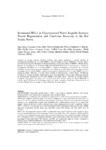Mostrar o rexistro simple do ítem
Intraneural IFG-1 in cryopreserved nerve isografts increase neural regeneration and functional recovery in the rat sciatic nerve
| dc.contributor.author | González Porto, Sara Alicia | |
| dc.contributor.author | Doménech, Nieves | |
| dc.contributor.author | Blanco García, Francisco J | |
| dc.contributor.author | Centeno, Alberto | |
| dc.contributor.author | Rivadulla, Casto | |
| dc.contributor.author | Álvarez Jorge, Álvaro | |
| dc.contributor.author | Sánchez Ibáñez, Jacinto | |
| dc.contributor.author | Rendal Vázquez, María Esther | |
| dc.date.accessioned | 2021-06-04T08:49:29Z | |
| dc.date.available | 2021-06-04T08:49:29Z | |
| dc.date.issued | 2018-07-27 | |
| dc.identifier.citation | González Porto SA, Domenech N, Blanco FJ, Centeno Cortés A, Rivadulla Fernández C, Álvarez Jorge Á, et al. Intraneural IFG-1 in cryopreserved nerve isografts increase neural regeneration and functional recovery in the rat sciatic nerve. Neurosurgery. 2019;85(3):423-431 | es_ES |
| dc.identifier.issn | 0148-396X | |
| dc.identifier.uri | http://hdl.handle.net/2183/28051 | |
| dc.description.abstract | [Abstract] Background: Insulin-like growth factor 1 (IGF-1) was found to stimulate Schwann cell mitosis. Exogenous IGF-1 may improve nerve regeneration after cryopreservation. Objective: To evaulate the effect of intraneural administration of IGF-1 in cryopreserved nerve isografts. Methods: Eighteen millimeter grafts were used for bridging an 18-mm defect in the rat sciatic nerve. A total of 57 rats were randomly divided into three groups: (1) autograft (Group 1); (2) cryopreserved isograft (Group 2); (3) cryopreserved isograft with intraneural IGF-1 administration (Group 3). 12 weeks after surgery, functional recovery (Sciatic functional index [SFI], Swing speed [SS], nerve conduction velocity [NCV], amplitude of compound motor action potentials [CMAP], and gastrocnemius muscle index [GMI]) and nerve regeneration (myelin sheath area, total fiber counts, fiber density, and fiber width) were all evaluated. Results: The intraneural injection of IGF-1 significantly improved SFI and SS at weeks 10 and 12. There were no statistical differences between Groups 1 and 3 in any of the SFI or SS evaluations. CMAP and NCV in Group 1 were significantly higher than in Groups 2 and 3, and Group 3 had significantly higher CMAP and NCV compared to Group 2. No significant differences were found in fiber width. The number of nerve fibers, percentage of myelinated fibers, fiber density, and GMI was significantly higher in Group 1 compared to Group 2, but no significant differences were found between Groups 1 and 3. Conclusion: The results show that intraneural injection of IGF-1 in an 18 mm cryopreserved isograft improve axonal regeneration and functional recovery. | es_ES |
| dc.language.iso | eng | es_ES |
| dc.publisher | Oxford | es_ES |
| dc.relation.uri | https://doi.org/10.1093/neuros/nyy339 | es_ES |
| dc.rights | This is a pre-copyedited, author-produced version of an article accepted for publication in Neurosurgery following peer review. The version of record is available online at Oxford Academic website. | es_ES |
| dc.subject | Albumin | es_ES |
| dc.subject | Cryopreservation | es_ES |
| dc.subject | Insulin-like growth factor I | es_ES |
| dc.subject | Peripheral nerves | es_ES |
| dc.subject | Sciatic nerve | es_ES |
| dc.subject | Tissue adhesion | es_ES |
| dc.subject | Tissue transplantation | es_ES |
| dc.title | Intraneural IFG-1 in cryopreserved nerve isografts increase neural regeneration and functional recovery in the rat sciatic nerve | es_ES |
| dc.type | info:eu-repo/semantics/article | es_ES |
| dc.rights.access | info:eu-repo/semantics/openAccess | es_ES |
| UDC.journalTitle | Neurosurgery | es_ES |
| UDC.volume | 85 | es_ES |
| UDC.issue | 3 | es_ES |
| UDC.startPage | 423 | es_ES |
| UDC.endPage | 431 | es_ES |
Ficheiros no ítem
Este ítem aparece na(s) seguinte(s) colección(s)
-
GI-NEURO - Artigos [132]
-
INIBIC-NEURO - Artigos [48]
-
INIBIC- REUMA - Artigos [183]






